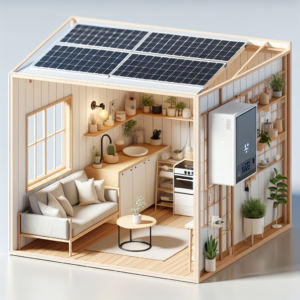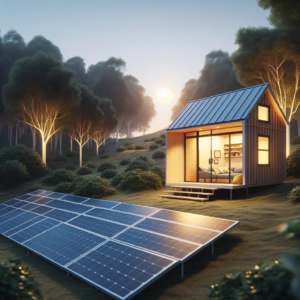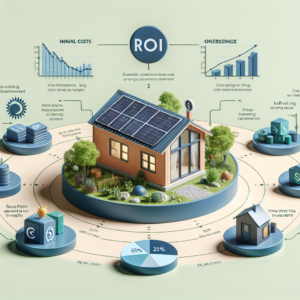
Key Takeaways
- Ground mounted solar panels offer flexibility and efficiency for tiny homes.
- Calculating your energy needs is crucial for choosing the right solar panel system.
- Renogy, HQST, Eco-Worthy, Rich Solar and Newpowa are top picks for ground mounted solar solutions.
- Proper placement and installation are key to maximizing solar panel efficiency.
- Investing in solar energy can lead to significant long-term savings for homeowners.
Why the Right Solar Panels Matter
Choosing the right solar panels for your tiny home isn’t just about going green; it’s about ensuring a consistent and reliable energy source that matches your lifestyle. Tiny homes have unique energy needs, and ground mounted solar panels are a great solution to meet those needs without the space constraints of rooftop panels. The right system can provide independence from the grid, reduce your carbon footprint, and save you money in the long run.
Unique Advantages of Ground Mounting
Ground mounted solar panels are a popular choice for tiny home owners for several reasons. First, they don’t require a large, sturdy roof, which many tiny homes lack. Additionally, they allow for optimal orientation toward the sun and easier cleaning and maintenance. Here’s why ground mounting can be a game-changer:
- You can position the panels for maximum sun exposure, increasing efficiency.
- Maintenance is simpler since you don’t have to climb onto a roof to access the panels.
- Expansion is easier if you decide to increase your energy production later on.
Why the Right Solar Panels Matter Top Solar Panel Picks for Ground Mounting
1. Renogy 100W Monocrystalline Solar Panel
Renogy’s 100W Monocrystalline panel is a favorite for its efficiency and durability. This panel is ideal for tiny homes due to its compact size and high performance in low-light conditions. It’s also built to withstand harsh weather, making it a reliable choice for all climates.
2. HQST 100W Polycrystalline Solar Panel
HQST offers a 100W Polycrystalline panel that’s great for those on a budget without sacrificing quality. While polycrystalline panels are generally less efficient than monocrystalline ones, this model provides a balance of efficiency and affordability, making it a smart option for tiny home owners looking to save on upfront costs.
3. Eco-Worthy 200W Monocrystalline Solar Panel
For those who need a bit more power, the Eco-Worthy 200W Monocrystalline solar panel is a solid choice. With a higher wattage, this panel can handle more energy-intensive appliances, making it suitable for tiny homeowners who aren’t willing to compromise on their energy needs. Its robust design also ensures longevity and consistent power output.
4. Rich Solar 100W Polycrystalline Solar Panel
Another excellent option for tiny homes is the Rich Solar 100W Polycrystalline panel. It’s particularly effective in areas with high temperatures, maintaining efficiency despite challenging conditions. This panel is also praised for its ease of installation and excellent customer support.
5. Newpowa 160W Monocrystalline Solar Panel
Newpowa’s 160W Monocrystalline solar panel strikes a balance between size and power. It’s compact enough for a tiny home’s limited space but provides a substantial power output to cover your daily needs. Moreover, it’s known for its high-quality construction and resistance to environmental stressors.
Insights into Solar Panel Efficiency
Understanding Solar Panel Efficiency
Efficiency is a crucial factor when selecting solar panels. It refers to the percentage of sunlight that a panel can convert into usable electricity. Monocrystalline panels usually have higher efficiency rates than polycrystalline panels, but they also come with a higher price tag. When choosing, consider how the efficiency will impact your overall system size and the space you have available.
Boosting Performance with Proper Placement
The placement of your solar panels significantly affects their performance. For the highest efficiency, panels should face south in the Northern Hemisphere to capture the most sunlight throughout the day. Additionally, the angle of your panels should be adjusted according to your latitude to optimize the amount of sunlight they receive. Here’s how you can ensure proper placement:
- Use a solar pathfinder to determine the best location for your panels.
- Adjust the tilt of your panels seasonally to follow the sun’s arc.
- Ensure there are no obstructions like trees or buildings that could cast shadows.
Installation Tips and Tricks
Secure Mounting Practices
When installing ground mounted solar panels, it’s imperative to secure them properly. This means using a mounting system designed to handle the weight of your panels and withstand environmental stresses such as wind and snow. Ensure the mounting system is anchored deep enough into the ground to provide stability and safety.
DIY vs. Professional Installation
Deciding between DIY and professional installation is a matter of skill level and comfort. If you’re handy and familiar with electrical systems, a DIY installation can save you money. However, if you’re unsure, it’s worth investing in professional installation to ensure your system is safe and effective. Here are some points to consider:
- DIY installation can be more cost-effective but requires a good understanding of electrical systems.
- Professional installers can guarantee a safe and efficient setup.
- Some warranties may require professional installation, so read the fine print
Cost-benefit Analysis
Breaking Down the Investment
Investing in solar panels involves upfront costs, but it’s important to consider the long-term benefits. A typical solar panel system might cost anywhere from $1,000 to $5,000, depending on the size and quality. Remember to factor in potential incentives like tax credits and rebates, which can significantly reduce your initial outlay.
Long-term Savings Projection
The savings from solar panels can be substantial over time. By generating your own electricity, you can reduce or eliminate your power bill. Over the course of 20 to 25 years, which is the average lifespan of a solar panel, you could save tens of thousands of dollars, depending on your energy usage and local electricity rates.
Maintenance and Upkeep
Regular Maintenance Schedule
Maintaining your solar panels is relatively simple but essential. Regular cleaning to remove dirt, leaves, and snow will ensure they operate at peak efficiency. It’s also a good idea to check the mounting system periodically to make sure it’s secure. A well-maintained system can last for decades.
Dealing with Weather-Related Challenges
Ground mounted solar panels are exposed to the elements, so it’s important to consider weather-related challenges. High winds can put stress on the mounting system, while hail can damage the panels themselves. Choose panels and mounting systems rated for your area’s weather conditions to prevent damage.
In Summary
Ground mounted solar panels are a fantastic option for tiny homes, providing flexibility, efficiency, and the potential for expansion.
Renogy, HQST, Eco-Worthy, Rich Solar and Newpowa are top picks for ground mounted solar solutions.
By understanding your energy needs, choosing the right panels, and ensuring proper installation and maintenance, you can enjoy a reliable and sustainable power source for years to come. Harness the power of the sun, and take a significant step towards energy independence for your tiny home.
Frequently Asked Questions
1.How many solar panels do I need for my tiny home?
The number of solar panels you need depends on your energy usage. An average tiny home may require between 6 to 10 panels of 100W each to cover its energy needs. However, this can vary widely based on your specific appliances, usage habits, and the efficiency of the panels you choose.
2.What are the best ground-mounted solar panels for shaded areas?
For shaded areas, look for panels with good low-light performance. Monocrystalline panels typically perform better in such conditions. Additionally, consider panels with bypass diodes, which minimize the impact of shading on panel performance.
3.Are ground-mounted solar panels more efficient than roof-mounted ones?
Efficiency isn’t about the mounting method; it’s about placement and panel type. Ground-mounted panels have the advantage of optimal placement for sun exposure, which can make them more efficient than roof-mounted panels that are restricted by the roof’s orientation and angle.
4.Can I install ground-mounted solar panels by myself?
Yes, with some electrical knowledge and the ability to follow instructions carefully, you can install ground-mounted solar panels yourself. However, for safety and warranty reasons, it’s often better to have them installed by a professional.
5.What maintenance is required for ground-mounted solar panels?
Ground-mounted solar panels require minimal maintenance, which typically includes:
- Cleaning the panels several times a year to remove dust and debris.
- Checking the mounting structure for stability.
- Inspecting for any damage or wear and tear, especially after extreme weather.



